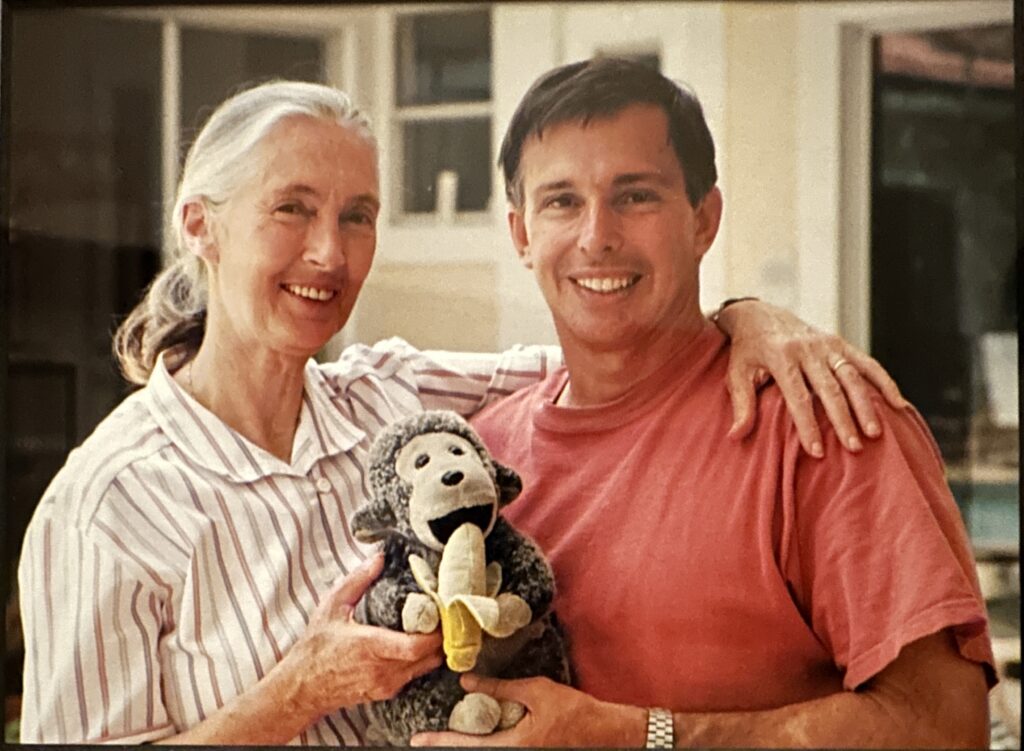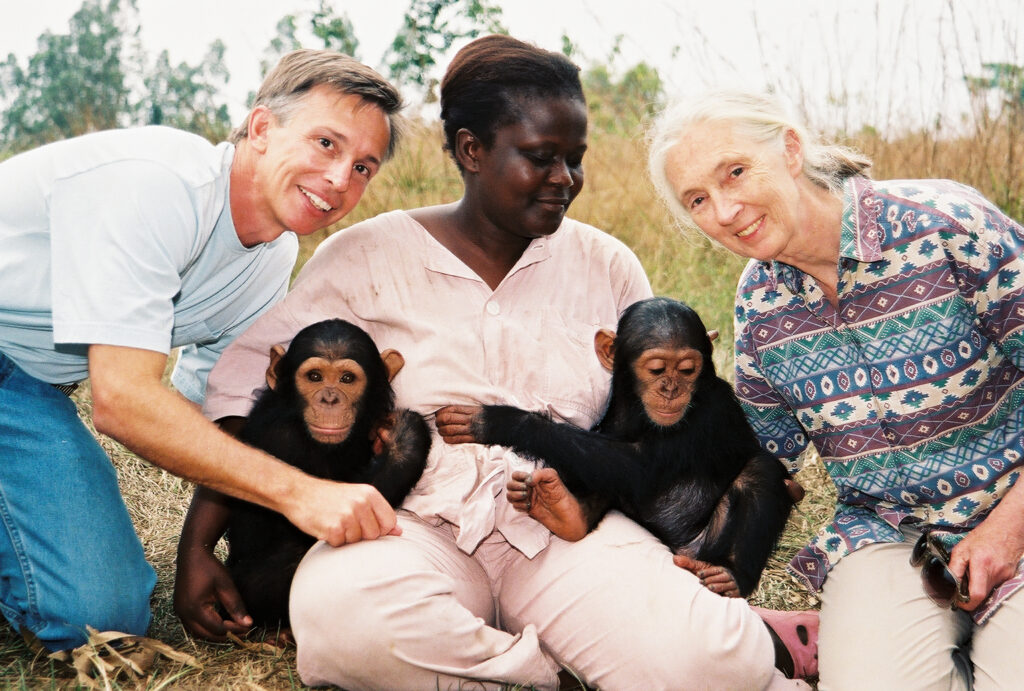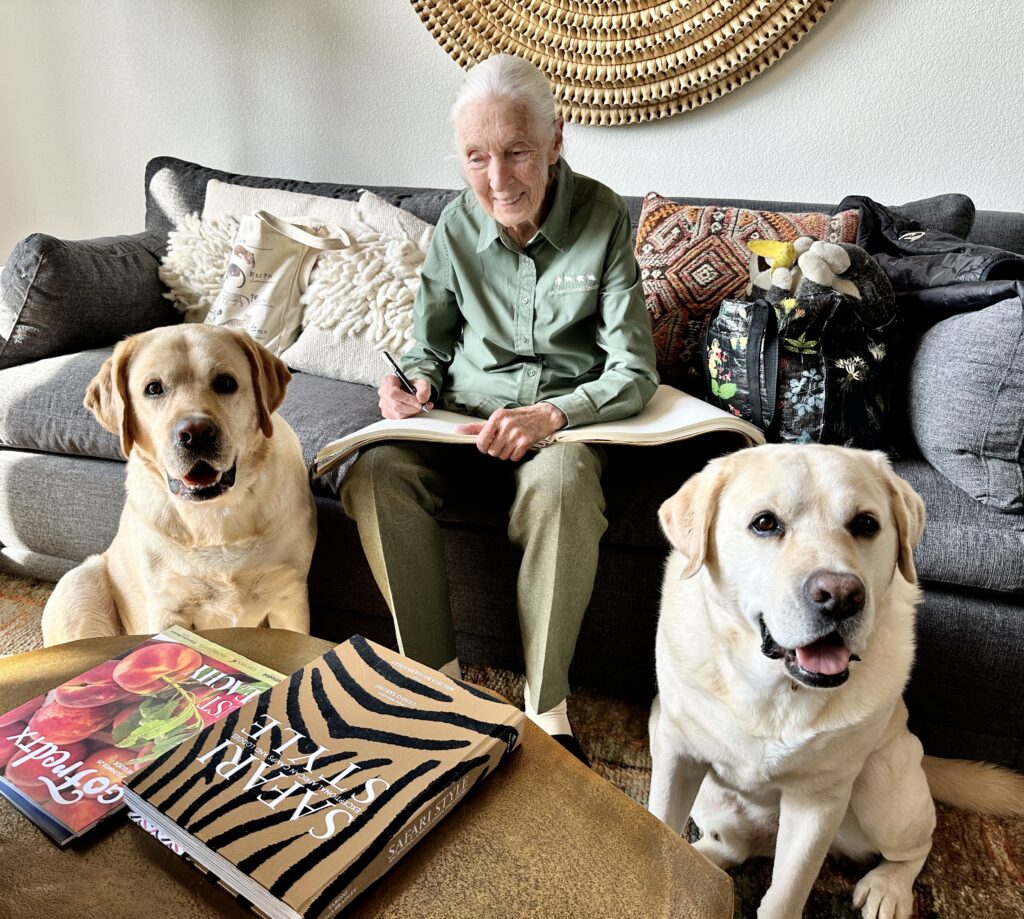It still feels surreal to write these words: Jane Goodall passed away peacefully in her sleep on October 1, 2025 at the age of 91. Just ten days earlier, we’d said goodbye at Longneck Manor. I had no idea it would be the last time.
Trying to capture the essence of Jane—the warmth, wit, and bottomless empathy she had for both animals and people—feels impossible. But I’ll try. Because she deserves that, and so much more.
Our First Meeting

I first met Jane in an Italian restaurant in Los Angeles in 1994. I was a bit starstruck (who wouldn’t be?), but Jane and her longtime friend Mary Lewis, then VP of the Jane Goodall Institute (JGI), quickly put me at ease. They were delightful—sharp, funny, and endlessly curious. I could also feel Jane’s eyes studying me, like she was quietly assessing my character and motivation.
We were meeting because I wanted her to take a “sneak peek” at a secret Disney project still in development—what would become Disney’s Animal Kingdom. The next week, she came to visit Imagineering headquarters (affectionately called the Bowling Alley). Joe Rohde and his team of Imagineers lined up like excited kids, clutching copies of In the Shadow of Man for her to sign.
Not a fan of most zoos, Jane’s skepticism began to fall away as she toured the project and asked question after question. She began to see that this wasn’t a typical zoo—it was something very different: “a new species of theme park,” one that told stories of wildlife and conservation in a way only Disney could.
From that day on, Jane became one of the park’s strongest advocates—not because of Disney’s name, but because she believed in the mission and the people behind it.
The Tree of Life and David Greybeard
During the park’s construction in Orlando, I gave Jane an after-hours “hard hat” tour. We stood before the massive Tree of Life—150 feet tall, with a huge trunk covered with carvings of over 400 animals. From afar, it looked like a gnarled old tree; up close, however, it came alive in fantastic detail.
I asked if she wanted to climb to the top scaffolding—the so-called “dance floor.” Without hesitation, Jane grabbed the ladder and quickly zipped up, leaving me scrambling to keep pace with this 62-year-old primatologist!
As she looked out over the 500-acre park, she quietly remarked that she did not see a chimpanzee carved on the trunk. Sure enough, she was right; there wasn’t one. I had not realized this was indeed the case.
The next day, I found the head sculptor, the talented Zsolt Hormay, and asked him if he knew who Jane Goodall was. “Of course,” he said, “the chimp lady!” I sent him a photo of a very handsome adult male chimp named David Greybeard, Jane’s favorite wild chimp and the first to take food from her hand. (He was very likely the inspiration for the famous Gary Larson cartoon of two chimps sitting on a branch with the one saying to the other “Well, well, another blond hair … conducting a little more ‘research’ with that Jane Goodall tramp?”)
Weeks later, Zsolt revealed his secret masterpiece: a larger-than-life sculpture of David Greybeard, twig in hand, “fishing” for termites. He was magnificent! The only animal on the Tree with a name, he was kept hidden until the grand opening of Disney’s Animal Kingdom on April 22, 1998. When Michael Eisner unveiled David to Jane, it was one of those unforgettable moments—pure joy, pride, and a quiet nod to a lifelong friendship between a woman and a chimpanzee.
Shared Interests and a Growing Friendship
When I left Disney in 2000 to become Director of the Houston Zoo, Jane and I kept in touch. She stayed with us a few times, both in Orlando and Houston, and she wrote letters—real, handwritten ones—that I still treasure. She was always writing, whether a letter of thanks or encouragement, a book, or a foreword to a book.
Jane and I participated together in a panel discussion at a Wildlife Conservation Network conference about how good zoos can do more for wildlife conservation. I introduced her to several zoo director friends who were committed to zoo-based conservation.
Jane loved all animals, but dogs were her favorite. She would frequently say in her lectures and interviews that her first dog Rusty was her greatest childhood teacher. Abby and Barkley, our dogs at that time, adored Jane and she adored them right back. In our last visit together, less than two weeks ago at Longneck Manor, my current labs Drifter and Boone also got to experience Jane’s deep affection and loving attention.
She often remarked that dogs love unconditionally, with no judgment and no ego. Chimpanzees, she’d add with a twinkle in her eye, were a little too much like humans— some good and others not so much.
One time she was on the living room floor with Barkley, and he got so excited he briefly attempted to mount Jane. I immediately yelled at him only to be corrected by Jane telling me it was not his fault and not to make him feel bad! Jane was defending him for just being a dog and not applying our human standards. It is a memory and image that still makes me laugh to this day.
Africa with Jane

During my 15 years at the Houston Zoo, we would communicate via email or in person during her visits. I was a bit critical of all the time and money her organization spent on chimpanzee sanctuaries in Africa, especially Tchimpounga in the Republic of the Congo. I thought she should focus more on saving wild chimps and their habitats. Her response was always that she could not ignore them because they needed our help, too. In 2004 she invited me to travel with her to Tchimpounga to see for myself why these orphaned chimps needed support just as much as the wild populations.
So, on July 24, 2004, Jane and I were on an Air France plane from JFK to Paris and then on to Pointe Noire, Republic of the Congo. We flew first class on Air France— traveling no less than 300 days a year meant Jane racked up a ton of frequent flyer miles!
We had some interesting and fun conversations on the long flights. Jane never slept much, usually preferring to stay up late talking and sipping her single malt scotch whiskey (no ice and just a pinch of water). Sometimes, in the presence of friends, she was known to display childlike enthusiasm. Like when she wanted to put on the silly pajamas provided by Air France just to get a picture, but fell asleep before she had the opportunity.
She often spoke of her second husband and true love of her life Derek Bryceson, Director of Tanzania’s National Parks in the 1970s. Sadly, Derek died of cancer in 1980. After his death, Jane never married or even dated again, though she had many admirers and even proposals. Jane felt she had a more important calling in life. We both joked about how many people commented about her attractive legs when she was following the chimps in Gombe National Park in her shorts and flip flops. I once teased her that she should cut her hair and sell locks on eBay to raise money for the chimps, and she liked the idea.
I kept a journal for the entire trip to remember the unique opportunity I had spending time with Jane in her Africa. I was no stranger to Africa, having visited more than 30 times myself, leading eco tours or developing an okapi conservation project, but I had never been to this remote area of west Africa.
We arrived in Pointe-Noire at 6:30 a.m. on Sunday, July 25, 2004. Pointe-Noire is the second largest city and principal port of Republic of Congo. The chimpanzee sanctuary is about a three-hour drive from the city in a reserve that is supposedly protected from hunting. It held 116 chimps at the time of our visit. They were divided into five age groups with the oldest chimp having access to a large electric fenced forest enclosure.
I spent six nights in my small tent on the grounds of the Tchimpounga. Jane’s tent was just down a way from mine, the furthest away from any other people. My most vivid memories from this mini adventure involve the chimps’ night calls filling the air—wild, eerie, and reminiscent of an all-night frat party. I’ll never forget it.
One day we went into an enclosure with two very old chimpanzees, Gregorie and Lavallae. Gregorie was rescued from the Brazzaville Zoo where he survived for many years in a small cage begging for food from visitors and entertaining them by smoking cigarettes. Jane knew these two chimps very well and she sat quietly with them—no words needed, just soft gestures and mutual understanding. By witnessing how Jane communed with these chimps, I gained a new appreciation and sympathy for all the orphaned chimps that had been snatched away from their dead mothers’ arms and needed help to survive. I now understood this special place providing life-saving rehabilitation and sanctuary for chimps under severe threat from trafficking and poaching.
The Essence of Jane
Jane was truly at home in Africa, living a minimalist lifestyle as close to nature as possible. She liked to end most evenings in Africa with worldly conversation around a campfire and a nip of scotch. An entry from my African journal went like this, “Jane is an amazing person – usually serious, but young at heart…sometimes stubborn (mentally tough), but always walking the talk.” As an example of her warm, light-hearted nature: one time Jane saw me writing a postcard to my mother and added her own personal “Hello, Rick’s Mom, I look forward to meeting you some day.”
Jane could have lived as a wealthy celebrity, but instead chose a simple, mission-driven life. She gave almost everything back to her foundation. The more time I spent with her, the more I admired how deeply she walked the talk. I grew in appreciation of her ability to “read” people and animals—she was a master observer. She could talk to presidents and preschoolers with the same calm, luminous presence.
Once, I asked if she believed in God. She smiled and said, “Yes, I believe there is a God, but religion gets in the way sometimes.” (She didn’t like being quoted directly, but I think she’d forgive me this one.)
I wouldn’t claim we were close friends, but I do believe she respected me—and I certainly respected her more than anyone I’ve ever known.

Goodbye, Jane
Jane Goodall changed the way the world sees animals—and ourselves. She made us realize the individual nature of every creature. I will always remember her as a warm and caring person with an unwavering commitment to make the world a better place for all its inhabitants. She was fierce, but gentle; endlessly curious, and always compassionate. She was the “ultimate Jane” in my opinion—the one “who would have been a far better mate” for her childhood hero Tarzan of the Apes … and those were her own words!
To me, she is the truest example of a life well-lived —with purpose, passion, and love for all living things.
Thank you, Jane. The world is better because you walked through it and touched our hearts and souls.
Rick Barongi
October 2025


